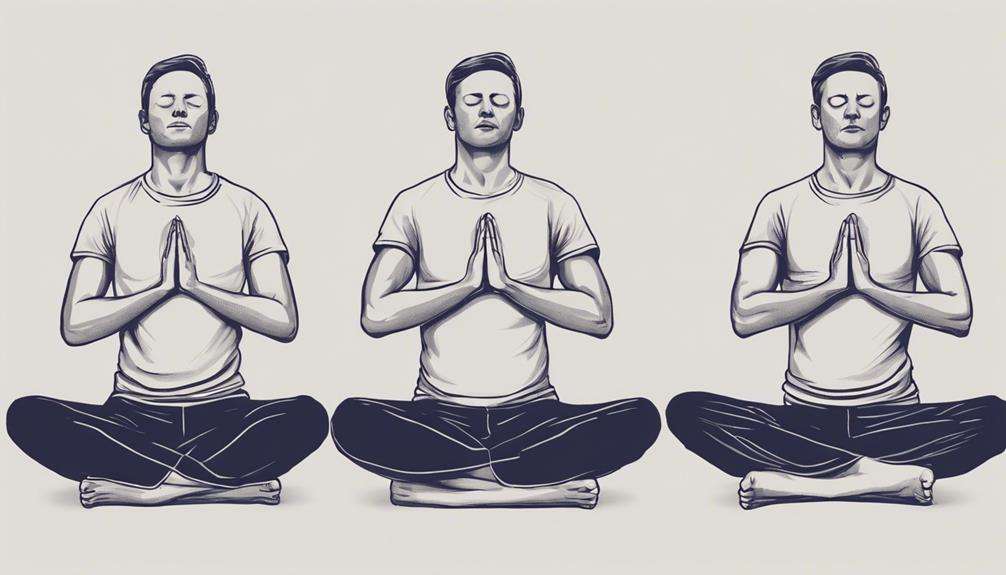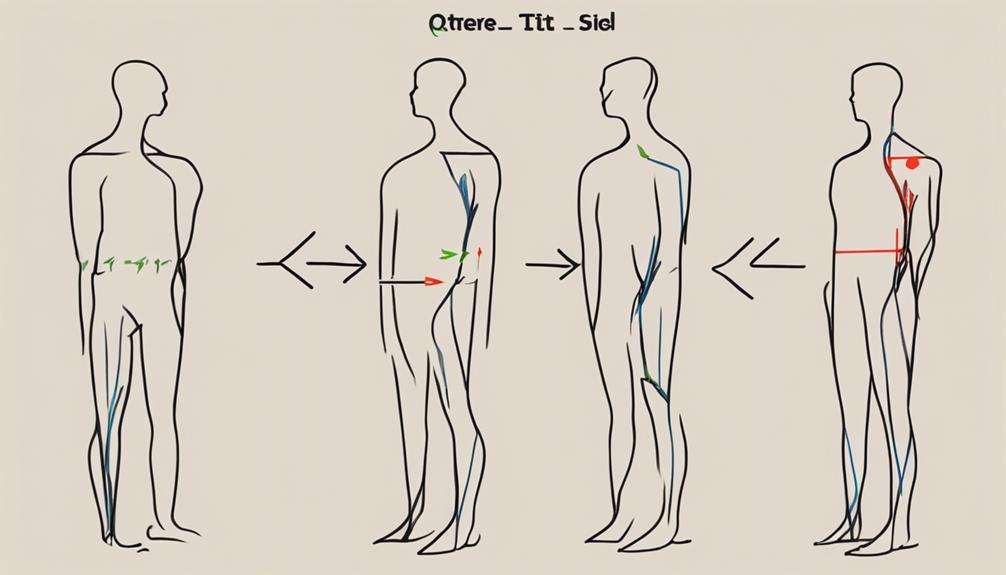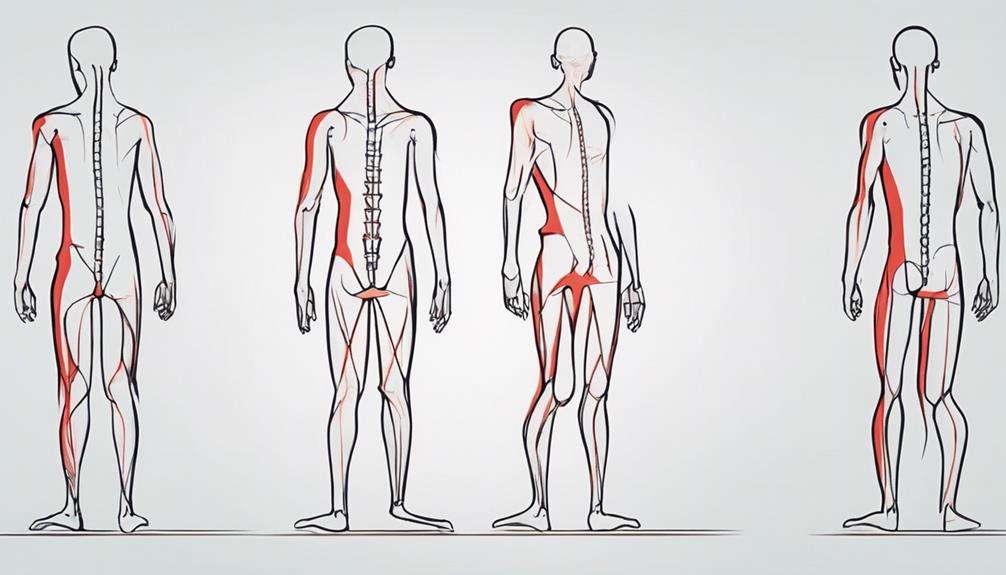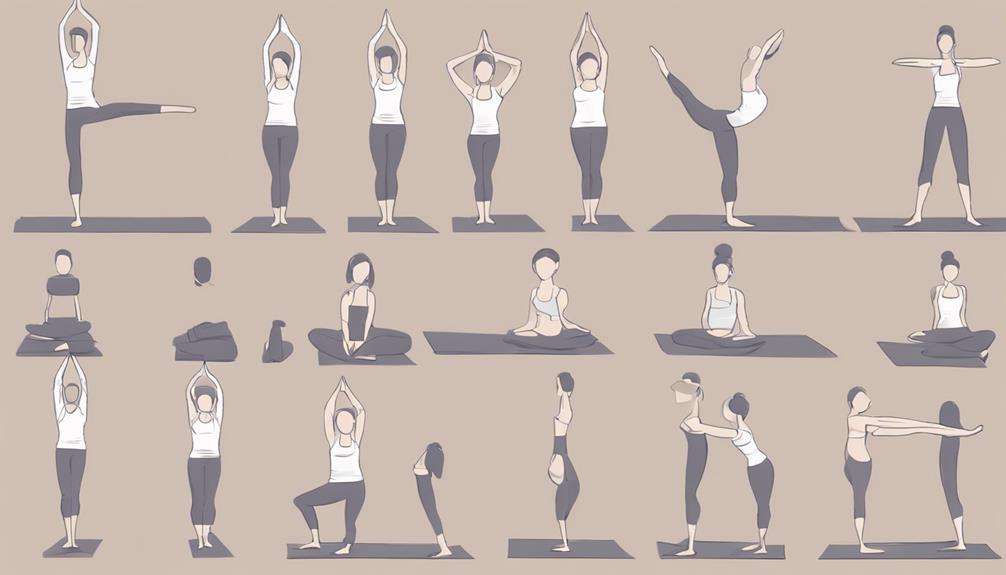You might not realize that small daily habits can have a significant impact on your posture and overall well-being. By incorporating consistent practices into your routine, you can improve your posture and feel better physically.
Curious to discover the ten daily practices that can help you achieve better posture and wellness effortlessly? Let's explore how simple adjustments and mindful actions can transform your posture and enhance your quality of life.
Key Takeaways
- Yoga poses like Cobra and Tree strengthen back muscles for improved posture.
- Morning routine incorporating Cat-Cow and Forward Fold enhances flexibility and alignment.
- Breathing exercises and meditation support core strength and body awareness for better posture.
- Evening yoga flows and core exercises help maintain postural stability and alignment.
Yoga Poses for Improved Posture
To enhance your posture and overall wellness, incorporating specific yoga poses into your daily routine can be highly beneficial. Yoga poses such as Cobra and Cat-Cow are excellent for strengthening and stretching the spine, which can lead to better posture over time. The Cobra pose works to strengthen the back muscles, promoting an upright posture, while the Cat-Cow pose helps in improving the flexibility of the spine, aiding in better alignment.
Additionally, poses like Upward-Facing Dog are great for opening up the chest and countering slouching, ultimately contributing to improved posture. The Tree pose is effective in enhancing balance and alignment, which are essential elements for supporting good posture. Moreover, the Downward-Facing Dog pose is known for lengthening the spine and relieving tension in the back, promoting proper posture alignment.
Warrior II pose in yoga is another beneficial posture-improving pose as it strengthens the legs and core muscles, which are essential for maintaining a good posture throughout the day. By incorporating these yoga poses into your daily routine, you can strengthen your spine, improve your posture, lengthen your spine, and enhance your balance, leading to overall better posture and wellness.
Morning Stretching Routine for Posture
Incorporate a morning stretching routine into your daily practice to improve posture by increasing flexibility and reducing muscle stiffness. Stretching in the morning can target key areas essential for posture improvement, such as the spine, hips, and shoulders.
Including stretches like Cat-Cow, Child's Pose, and Standing Forward Fold can help enhance flexibility and reduce tension in these areas. Consistent practice of a morning stretching routine not only prepares your body for the day ahead but also supports proper alignment, reducing the risk of muscle imbalances.
By enhancing circulation and promoting relaxation, these stretches set a positive tone for maintaining good posture throughout your daily activities. Starting your day with a focus on stretching can have long-term benefits for your posture, overall wellness, and energy levels.
Posture-Boosting Breathing Exercises
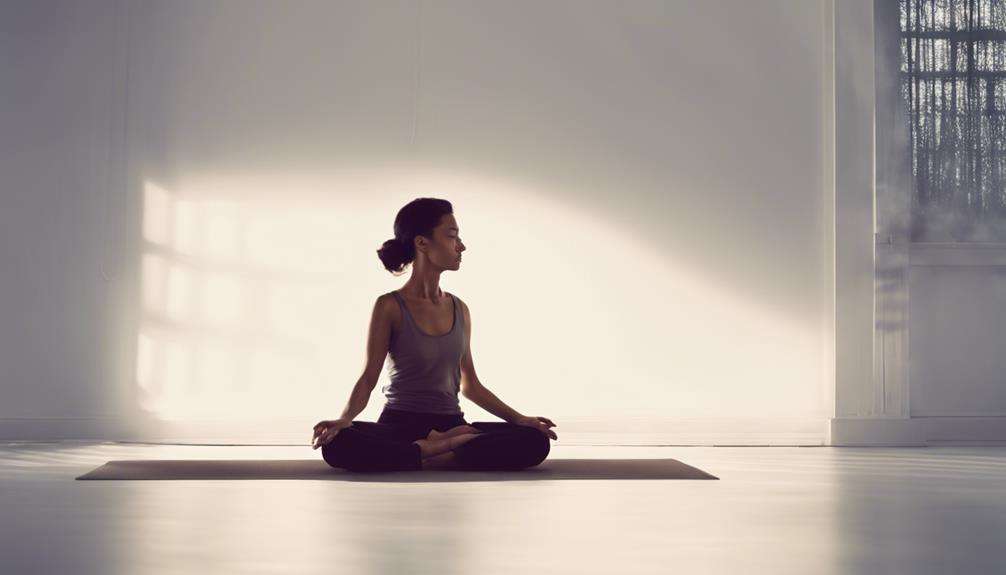
Engage in diaphragmatic breathing techniques to strengthen your core muscles and support proper alignment for improved posture. By focusing on your breath, you can enhance body awareness and encourage a straighter spine throughout the day.
Remember that deep breaths not only promote relaxation and reduce stress but also stimulate the parasympathetic nervous system for better posture and overall wellness.
Diaphragmatic Breathing Technique
Enhance your posture and wellness with the effective Diaphragmatic Breathing Technique, a powerful method for promoting deep, efficient breathing.
Diaphragmatic breathing involves utilizing the diaphragm muscle to enhance oxygen flow, reduce stress, and induce relaxation. By engaging the core muscles and facilitating spinal alignment, this technique supports proper posture.
It also aids in decreasing tension in common areas affected by poor posture, such as the neck and shoulders. Regular practice of diaphragmatic breathing can lead to increased energy levels and an overall sense of well-being.
Incorporating this technique into your daily routine can help you maintain better posture, reduce stress, and improve your overall health and wellness.
Postural Alignment Breaths
To further improve your posture and overall wellness, consider practicing Postural Alignment Breaths, breathing exercises that target core muscles and promote spinal alignment. These breaths enhance body awareness, aiding in aligning the head, shoulders, and hips correctly.
By engaging in postural alignment breaths, you can reduce tension on bones and joints, relieving discomfort and enhancing mobility. Deep breathing techniques incorporated into these exercises help strengthen core muscles and boost energy levels.
Consistently integrating postural alignment breaths into your daily routine can have a notable impact on your physical well-being and posture positively. Make a conscious effort to focus on these exercises to experience the benefits of improved posture, reduced discomfort, and increased mobility.
Mindful Meditation for Posture Alignment
Mindful meditation can greatly influence your posture alignment by enhancing body awareness and fostering a sense of balance. By incorporating mindful meditation into your daily routine, you can improve your posture by increasing your awareness of how your body is positioned and moving throughout the day. This practice can help you identify areas of tension or discomfort that may be contributing to poor posture habits. Mindful meditation encourages you to focus on the present moment, allowing you to make conscious adjustments to your posture as needed to maintain a neutral spine and promote spinal alignment.
Moreover, practicing mindfulness can reduce stress and tension in your body, which can lead to better postural habits over time. By incorporating proper breathing techniques into your meditation practice, you can support spinal alignment and promote muscle relaxation, further contributing to improved posture. Overall, mindful meditation is a valuable tool for enhancing your body awareness, promoting balance, and ultimately improving your posture alignment for better overall well-being and long-term postural health.
Daily Posture Check-In Tips

Improving your posture starts with conducting regular check-ins to assess your alignment and make necessary adjustments. Stand against a wall to evaluate your spine curvature and make sure that your head, shoulders, and hips are in line.
Throughout the day, use a mirror to check for any signs of slouching or uneven shoulder height. When sitting, maintain good posture by keeping your feet flat on the floor and your thighs parallel to the ground.
It's important to regularly adjust your sitting position and take short breaks to relieve stress on your body and support best posture. By being mindful of your posture check-in routine and making small corrections as needed, you can prevent long-term issues associated with poor alignment and promote overall wellness.
Strengthening Exercises for Better Posture
Regularly engaging in strengthening exercises is essential for improving posture and overall musculoskeletal health. Strengthening exercises such as planks, bridges, and bird dogs are particularly effective in enhancing core muscles, which play a vital role in maintaining good posture.
Incorporating resistance training using bands or weights can target postural muscles like the back, shoulders, and core, promoting better alignment and support. Practices like Pilates and yoga routines are beneficial as they emphasize balance, flexibility, and strength, all of which are essential for correcting posture imbalances.
By engaging in exercises that specifically target the back extensors, abdominals, and shoulder stabilizers, you can further enhance postural support and alignment. Additionally, incorporating isometric exercises such as wall sits or plank variations can help build endurance in the postural muscles, ensuring sustained good posture throughout the day.
Prioritize these strengthening exercises to improve your posture and overall musculoskeletal well-being.
Posture-Friendly Ergonomic Adjustments

To optimize your workspace for better posture and overall well-being, consider making posture-friendly ergonomic adjustments. Ensuring your chair is adjusted to the correct height to maintain a 90-degree angle between your knees and hips can greatly reduce strain on your lower back.
Positioning your monitor at eye level is important to prevent neck strain and promote proper head alignment, ultimately supporting good posture. Using a footrest can help support your feet and maintain proper posture while sitting for extended periods, further reducing the risk of back pain.
Additionally, keeping your wrists straight and elbows close to your body while typing can minimize strain on your wrists and forearms. Incorporating lumbar support in your chair is also essential as it helps maintain the natural curve of your lower spine, ultimately reducing back pain and promoting proper posture.
Making these ergonomic adjustments won't only enhance your workspace but also contribute to better posture and overall wellness.
Relaxation Techniques for Posture Support
To support your posture, consider integrating relaxation techniques like deep breathing and stretching into your daily routine. These practices can help alleviate muscle tension and promote proper alignment, ultimately contributing to improved posture.
Breathing for Relaxation
Deep breathing exercises play an important role in relaxing muscles and promoting proper posture by releasing tension and enhancing oxygen flow. Techniques like diaphragmatic breathing and controlled breathing can help expand the lungs fully, improving oxygen circulation for better posture support.
By adopting proper breathing patterns, you can maintain spinal alignment and engage your core muscles effectively, contributing to overall posture alignment. Incorporating relaxation breathing methods into your daily routine can increase body awareness and mindfulness, fostering better posture habits.
These practices not only calm the mind and reduce stress but also support muscle relaxation, which is essential for maintaining good posture and overall wellness. Start integrating these breathing exercises into your daily regimen for improved posture and well-being.
Stretching for Alignment
Enhancing your posture through stretching for alignment involves:
- Lengthening muscles
- Reducing tightness
- Increasing flexibility to support proper spinal alignment and overall wellness.
Stretching not only helps improve posture by:
- Enhancing muscle flexibility
- Aiding in body alignment.
Incorporating deep breathing techniques during stretches can further enhance alignment and reduce tension.
By including daily stretching routines in your regimen, you can:
- Alleviate muscle imbalances
- Promote proper spinal alignment.
Regular stretching sessions also:
- Improve blood circulation
- Aid in muscle recovery
- Contribute to overall posture enhancement.
Prevent stiffness, improve your range of motion, and increase posture awareness by incorporating stretching into your daily routine for better alignment and overall wellness.
Core Strengthening for Postural Stability

Implementing core strengthening exercises into your fitness routine can greatly enhance your postural stability and overall body control.
Core exercises, such as planks and Russian twists, play an important role in improving postural stability by supporting the spine and maintaining proper alignment. A strong core is essential for good posture as it helps prevent slouching, reducing the risk of back pain and injuries. Regular engagement of the core muscles not only enhances balance and coordination but also contributes to better posture throughout the day.
Targeting the core muscles through activities like leg raises and bird dogs can further enhance postural stability and alleviate strain on the lower back. By incorporating core workouts into your daily routine, you not only strengthen your abdominal muscles but also promote a more upright and aligned posture. Strengthening your core is a key component in achieving better postural stability and overall wellness.
Evening Yoga Flow for Posture Alignment
Incorporating evening yoga into your routine can be beneficial for improving posture alignment.
Certain yoga poses like cobra, cat-cow, and child's pose specifically target postural muscles and spinal flexibility.
Yoga Poses for Alignment
Engage in an evening yoga flow focused on posture alignment with a series of essential poses targeting key muscle groups for improved spinal flexibility and awareness.
Start with Cobra, Cat-Cow, and Child's Pose to enhance spinal flexibility and alignment. Move into Downward-Facing Dog and Standing Forward Fold to promote proper posture.
Incorporate Upward-Facing Dog and Chest Opener poses for a chest-opening stretch that aids in posture improvement. Include Bridge Pose and Warrior II to strengthen core muscles, providing better support for your posture.
Benefits of Evening Yoga
To further enhance your understanding of the benefits of evening yoga for posture alignment, consider how this practice can positively impact your overall well-being. Evening yoga can improve posture alignment by stretching and strengthening muscles, leading to better spinal alignment and flexibility.
Engaging in yoga before bed relaxes the body and mind, promoting not only better sleep but also aiding in posture correction. Sunset yoga flows specifically target areas prone to postural issues, releasing tension accumulated throughout the day.
Frequently Asked Questions
What Should I Do Everyday for Better Posture?
To improve posture daily, start with desk stretches, take yoga breaks, do a posture check, build core strength, and practice mindful sitting. These habits will enhance alignment, prevent stiffness, and support spinal health.
What Is a Good Posture in Everyday Life?
In everyday life, good posture involves aligning your ears, shoulders, and hips vertically. Confirm proper sitting habits, standing alignment, walking techniques, suitable sleeping positions, and consistent exercise routines to support a healthy spine and overall well-being.
Which Is a Good Practice for Good Posture?
To maintain good posture, focus on core strength and mindful sitting. Engage in posture exercises and stretching routines. Guarantee proper alignment at your desk setup, consider chair ergonomics or standing desks for posture support.
How Do I Train Myself to Have Good Posture?
To train yourself for good posture, start with posture exercises focusing on core strength. Pay attention to alignment cues while sitting mindfully in an ergonomic workspace. These practices build awareness and support better posture habits.
Conclusion
Congratulations on completing these 10 daily practices for better posture and wellness!
Now that you've mastered the art of sitting up straight and breathing deeply, you're on your way to becoming a posture guru.
Remember, good posture isn't just a trend, it's a lifestyle.
So keep stretching, breathing, and meditating your way to a healthier and happier you.
Your spine will thank you!
Keep up the good work, posture perfectionist!

